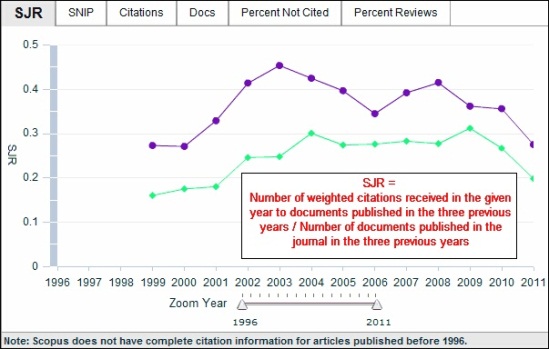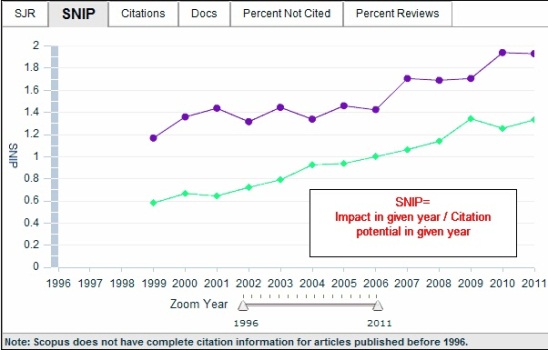SCImago Journal Rank (SJR) and Source Normalized Impact per Paper (SNIP) go back to 1999. The basic calculation for both journal metrics is the Impact in a given year. This value is calculated by dividing the number of citations received by the journal in the given year from primary items (articles, reviews and conference papers) to primary items published in the three previous years by the number of primary items published in the journal in the three previous years.
SCImago Journal Rank (SJR) is a measure of the scientific influence or prestige of a journal. The SJR metric is based on Google PageRank™ algorithm. It measures the weighted citations per document. Citations are weighted depending on the prestige of the source where they originate. A SJR value of 1.5 in a given year means that the primary items (articles, reviews and conference papers) published in the journal in the three previous years received, on average, one and a half weighted citations in the given year.

Line Chart of SJR of two journals in Scopus Journal Analyzer
Source Normalized Impact per Paper (SNIP) measures a journal's contextual citation impact by "normalizing" citation values. The SNIP value is corrected for differences in citation behaviour (the frequency of citations) across research fields and database coverage. SNIP is the Impact in a given year divided by Citation Potential in the given year. A value of 1.5 in a given year means that the primary items (articles, reviews and conference papers) published in the journal in the three previous years have been cited, on average, one and a half time more frequently in the given year than primary items in other journals within the same subfield.

Line Chart of SNIP of two journals in Scopus Journal Analyzer
In Scopus Journal Analyzer (SJA) you can compare and evaluate the SJR, SNIP and other performance measures of up to ten journals at a time.
Note that the SJR and SNIP metrics (based on Scopus data) are different from Impact Factors provided by the Journal Citation Reports (based on Web of Science data).
SJR and SNIP have been integrated into Scopus Journal Analyzer in January 2010. As well as JCR's Impact Factors, the SJA's journal metrics have limitations.
SJR and SNIP journal metrics are also freely available online on the www.journalmetrics.com website. SJR is also freely available on the SCImago Journal & Country Rank website.